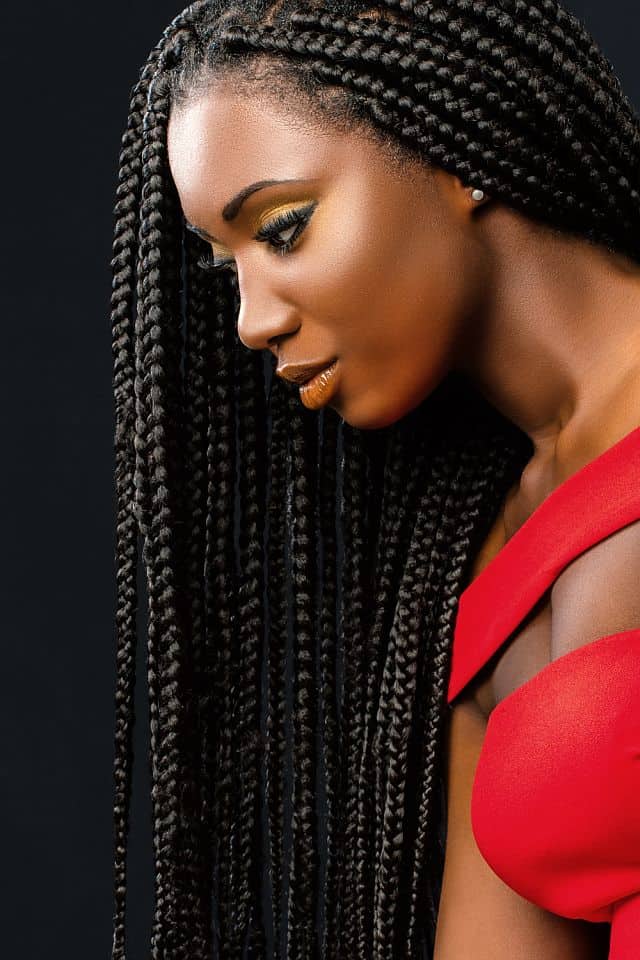Last Updated on December 18, 2022 by Vera Aduongo
Written by Vera AduongoDon’t you just love crochet locs?! Crochet locs came onto the scene a couple of years ago and since then, our lives have never been the same. They’re beautiful and extremely versatile, but there are a lot of questions surrounding them like how many packs to use, how to install them, how to relieve tight locs, and so much more. But first, let’s define what they even are.
What are Faux Locs, Goddess Locs, Soft Locs, and Butterfly Locs?
Faux locs are, as the name suggests, a hairstyle where one tries to emulate the look of dreadlocks without actually locing their own hair. The OG faux locs were smooth and wrapped tightly down, giving them a smooth, shiny look and feel. They were stiff when installed, only loosening up with wear. The faux locs’ overall texture becomes more natural over time. Eventually, people start to think that you actually got dreadlocks done on your hair. You can use any type of hair to achieve this look, but for a more natural look, try either Marley hair or Cuban Twist hair.

The most recent variation of faux locs that I’ve seen is soft locs. Soft locs follow the same principle as O.G. Faux Locs, but the hair is wrapped more loosely to allow it to have natural movement from the moment the locs are installed. Another plus is the texture of soft locs tends to look more natural from the get-go; it has a bit of frizz without looking messy. This may partly be because soft locs are often made with a combination of ready-made faux locs and then wrapped at the top with a lightly separated passion twist, spring twist, or water wave hair.
Distressed locs, also known as Butterfly locs, Messy faux locs and Bohemian locs, get their name because the loc is wrapped in such a way that it looks distressed or isn’t smooth all the way down. For this type of locs, you’ll use some type of water wave hair to wrap, and may also need some normal braiding hair or Marley’s hair to make the base of your locs thicker.
Goddess locs are faux locs that have some type of wavy or curly loose hair added at the end of the loc and randomly added onto the length of the actual loc. The most common “messy” hair that’s added to the loc is Deep Twist or water wave hair.
Do Crochet Locs Break the Hair?
No, crochet locs aren’t damaging, as long as they are done properly. If they’re done too tight or you neglect your hair while you have them in, then they can be damaging to your hair. So make sure they’re not done too tight (which I’ll cover later on in this article). Also, make sure to moisturize your hair and scalp regularly to avert any breakage that may result from your hair dryness.
How Long Do Crochet Locs Last?
All crochet locs except butterfly/distressed locs can easily be worn for 6+ weeks with proper care. Boho/butterfly/distressed locs will start to look really messy around Week 2, and if you can deal with that, then you can easily wear them for 4 weeks. Stay tuned for the details on how to care for them properly so that they last.
How To Install Faux Locs, Soft Locs, Butterfly Locs, or Goddess Locs?
Generally, there are 3 ways of installing all types of crochet locs:
- Braiding your hair and then adding crochet hair to your hair and wrapping to form the loc,
- Crocheting ready-made locs on braided or twisted hair, or
- Crocheting ready-made locs on cornrows.
Since this hair trend has been out for a while, there are tons of companies that now offer ready-made crochet locs (recommendations in the next section). If you’re looking for the shortest installation time, then ready-made is definitely your best bet. For the most natural look, opt for either the braid-and-wrap method or the ready-made locs on individual braids or twists.
How Many Packs of Hair Do I Need for Faux Locs, Butterfly Locs, or Goddess Locs?
For Butterfly or Distressed Locs:
For medium-length/shoulder-length locs, 6-8 packs of loose hair (for wrapping) should be just fine. When purchasing ready-made locs, 6 to 7 packs should be enough for medium-width locs (different brands pack a different amount of locs in each pack, but aim for around 70-80 locs total). If you’d like small (not tiny) locs that have a natural-looking low density, 8 to 10 packs (95-110 locs) should be okay. For chunky locs, 5 to 6 packs of ready-made locs should be enough for a natural density (50 locs).
Here’s our favorite brand of loose hair: Freetress Water Wave 22” and ready-made locs: ToyoTress Butterfly Locs.
For Goddess Locs, Soft Locs, and Faux Locs:
Regardless of length, 6 packs (about 100-120 locs total) should be enough for a full look. If you want more volume, then go with 8 packs. These types of crochet locs almost always come in a small-medium size, so this estimate is for that size. If you buy loose hair, then you’ll need about 2 packs of filler hair (which can be anything) and use about 3-4 packs to wrap the filler hair and your own hair. If you want a natural sheen and some texture, opt for something like Cuban Twist hair. For the curly ends of your goddess locs, 2 packs of Deep Twist will be perfect!
Here’s our favorite brand of loose hair: Freetress Equal Synthetic Hair Braids Double Strand Style Cuban Twist Braid 16″ (3-Pack), fave loose hair for goddess locs’ wavy ends: Freetress Deep Twist 22″ Crochet Hair, fave ready-made faux or soft locs: Youngther 14-24 Inch Faux Locs Crochet Hair 6 Packs, and fave ready-made goddess locs: Sambraid Goddess Locs Crochet Hair (14-22 Inches).
P.S: If you have a small head, then you’ll need more packs than what’s recommended here to achieve a full look.
How Do I Keep My Crochet Hair From Being Bulky At The Base?
Crochet locs can look really bulky at the bottom where the initial loop attaches the crochet hair to your hair. There are two methods that I suggest to solve this problem:
1. When doing the initial loop at the base, only pull your hair through that loop. If you pull both your hair and the crochet hair through the loop, it will cause you to have a bulky knot at the base.
2. Try knotless crochet locs. To do this, you’ll braid your hair all the way down. Then similar to what you would do with knotless braids, you’ll add the hair a couple of centimeters into the braid.
Start by inserting your crochet hair into the braid, then place the loop onto the hook and close the latch. Pull the crochet hair through the braid. Then pull your own hair through the loop at the base of the crochet hair. Lightly tug at your braid and the crochet loc to tighten the knot at the base. Now, when you start wrapping, you’ll wrap over that base a couple of times and then move down. If you do better with visuals, check out this video:
YouTube video: SOFT LOCS WITHOUT KNOTS (MY KNOTLESS METHOD)
How to Loosen Locs That Are Too Tight?
As a rule of thumb: your hair should not be so tight that you can’t sleep or have to take painkillers to survive. One way to avoid your crochet locs being too tight is to always start wrapping the hair below the initial knot- the initial loop, at the base of your hair, that forms when you first attach your crochet locs to your hair.
But in case you already got them done pretty tight, and you’re just figuring out a way to survive, I suggest that you:
- Try to loosen the base of the locs. You can do this by pinching the base of your loc and slowly twisting it in the opposite direction to how the hair was wrapped. If you do this correctly, after a few twists, you’ll realize that your hair feels a lot less tight. Do this for every single loc, and they should become loose enough that you can actually lay your head down and sleep.
- If you want to be able to loosen the hair up, even more, take some warm water and mix that with a conditioner and a bit of oil. The warm water will help soothe your scalp and the conditioner and oil will add some slip, which should help you loosen the locs even more in Step 1.
- Take a Tylenol/Panadol or Ibuprofen. Yes, I know I said you shouldn’t have to take anything, but you’re already in pain, so please don’t try and suffer through it.
- Take a warm towel and press that onto your scalp. I can’t even fully explain to you why this helps, but when you take off that hot towel, your scalp will have calmed down by a lot.
- If all these steps fail, take them out. It might be hard seeing as you probably spent a couple of hundred dollars for something that didn’t even last, but keeping it in is not going to be worth it. It’s not good for your hairline or your peace of mind.
YouTube video: 7 Tips to Loosen Too Tight Braids| Locs| Twists| IMMEDIATELY
How to Keep Your Faux, Soft, Butterfly, and Goddess Locs From Unraveling?
Got2B Freeze Spray! There are many methods you can use out there to keep your ends from unraveling, but this is the safest, most convenient, and most undetectable method out there. So here’s how to use it:
When you’re literally almost done wrapping, spray the Got2B on the ends of the crochet hair and finish wrapping. Then pinch that section and hold for a couple of seconds for it to adhere properly. Another variation that will be less messy is to spray some of the Freeze Spray on your finger and then apply it to the hair.
The other methods include burning the ends with a lighter, melting the locs with a flat iron, and using nail glue. Burning your ends with a lighter and melting it with a flat iron can burn your hair and cause your locs to be “sticky” and snag easily. I don’t like the nail glue option because it’s incredibly messy (your fingers stick together), and if your glue touches your actual hair, the takedown process will be, as we say in Kenya, “premium tears”.
How to Care for Crochet Locs o That They Last Longer
For all the deets on how to wash your crochet hairstyles and how to maintain them at night, check out our previous article on how to care for crochet hair. And if you used ready-made locs on cornrows, then that’s all you will need to do.
Now, I’m going to cover the extra things you should do on top of those practices if you have crochet locs.
1. ‘Retouch’ Your Roots
If you did your crochet on individual braids or twists, you’ll need to retwist your roots to keep the style looking fresh. You can do this by applying plain water, a water-based moisturizer, or a styling product to your new growth. Then pinch your new growth and start winding the hair. Keep going until the bases of the locs start to look new again, and you can clearly see your parts. Tighten them as much as you desire but be careful so you don’t make them way too tight.
P.S: I’ve done this a couple of times when I have braids and my hair has never loc’d at the toot. Now, granted, I wasn’t keeping them in for longer than 2 months at a time, and I was also washing and moisturizing my hair.
2. Retouch Your Locs
If your locs are looking quite frizzy all the way through, then take a small piece of the exact same type of hair you used to wrap your locs and wrap it over the top half of your loc. When you’re done, your locs should look as good as new. Tip: You can skip retwisting your roots (the previous step) and just use this method to touch up both your roots and your actual crochet locs. As long as you’re comfortable with leaving your roots frizzy between retouches, then you should be fine. Just make sure not to do this a lot because it will make your roots look bulky and unnatural.

Vera Aduongo is a seasoned writer whose journey was sparked by her own hair journey. When she looked on the internet and found a few sources that catered to her hair type, she started to share what she knew. First, with family and friends, and soon, with the ‘internets’. 7 years later, with a mane to boot, she’s not looking back! When she’s not contributing to a topic on natural hair and hair extensions, you can find her writing for Retail & Consulting brands, trying out new restaurants, binge-watching YouTube, and being an aunt to the 2 most handsome boys out there (IMO).
Vera lives in Nairobi, Kenya.

